Achieve screening success with pooled lentiviral libraries. High-quality pools, complete analysis tools, and validated protocols.
Highlights
- Pools of shRNA or microRNA gene families and pathways
- Customizable promoter and reporter options, including inducible promoters
- Complete workflow planning tools and protocols
- Custom human, mouse, and rat libraries available
Screen 100s or 1000s of genes without the need for costly automation
Use pooled lentiviral screens to identify genes that regulate cellular responses and signaling pathways, or to discover novel gene functions. Pooled screening libraries can consist of as few as 50 constructs up to many 1000s. In contrast to the costly automated techniques that are required in arrayed screen using individually arrayed reagents, pooled screening libraries allow the researcher to transduce and screen a population of cells within a few tissue culture dishes.
To learn more about the critical parameters of successful pooled lentiviral screening, including the conditions necessary for maintaining a high fold-representation, please download the following publication: Ž. Strezoska, A. Licon, Optimized PCR Conditions and Increased shRNA Fold Representation Improve Reproducibility of Pooled shRNA Screens. PLoS One 7, e42341 (2012).
All Horizon pooled lentiviral libraries include:
- High-quality pools provided as purified, concentrated lentiviral particles
- Choice of gene families or whole genome libraries
- Availability of custom collections, simply request a quote
- Planning tools and validated experimental and bioinformatics protocols for successful pooled lentiviral screens
Horizon products recommended in our validated Pooled Lentiviral Screening protocol:
- Optimized and validated vector-specific primer kits for
- Efficient PCR amplification of genomic DNA with minimal bias
- High-throughput multiplexed sequencing for hit identification
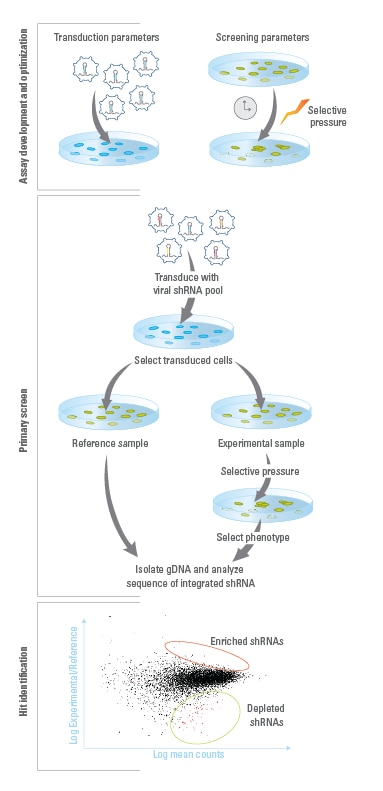
Assay Development and Optimization
Establish optimal experimental conditions, including those for a) lentiviral transduction and b) screening parameters, such as selective pressure and time between collection of reference and experimental samples.
Primary Screen
A stable population of cells expressing single integrants of constructs is created by transducing lentiviral pools at low MOIs. Transduced cells are then split into reference and experimental populations for application of a selective pressure that induces the phenotype of interest. Genomic DNA (gDNA) is then isolated from reference and experimental populations of transduced cells. Illumina-adapted primers and Phusion Hot-Start II High Fidelity DNA Polymerase are used to PCR amplify integrated construct sequences and add Illumina flow-cell binding sequences. The resulting amplicons are run on Illumina platform sequencers, using the sequencing primers provided.
Hit Identification and Follow-up
Construct sequences are identified in reference and experimental libraries. Constructs that are enriched or depleted during the screen are identified as hits, and the genes that they target are identified. Hits can be confirmed and studied further using individual constructs that can be ordered from the Dharmacon catalog collection.
-
SMARTvector Lentiviral shRNA Pooled Libraries
Constitutive shRNA expression for optimized functional analysis screens -
SMARTvector Inducible Lentiviral shRNA Pooled Libraries
Inducible shRNA expression for regulatable and controlled functional analysis screens -
shMIMIC Lentiviral microRNA Pooled Libraries
Perform functional screening of hundreds or thousands of microRNAs without high-throughput automation -
shMIMIC Inducible Lentiviral microRNA Pooled Libraries
Tight control of microRNA expression for powerful functional screening of hundreds or thousands of microRNAs. -
SMARTvector Indexing PCR and Sequencing Primer Kit
For use with SMARTvector and shMIMIC pooled libraries on Illumina systems
Successful pooled shRNA screening starts with high-quality pools
All Horizon lentiviral library pools are created using experimentally validated methods that ensure uniform representation of constructs in every lentiviral pool. After pooling, DNA is prepared from E. coli cultures and analyzed by high-throughput sequencing to evaluate construct representation and identity. This quality control allows Horizon to verify that > 95% of constructs are recovered after the pooling process and the abundance of 70% of the constructs is less than 5-fold different from each other and the abundance of 90% of the constructs is less than 25-fold different from each other. This quality control provides confidence in the uniformity of the Horizon pooled screening libraries and the ability to detect changes in construct representation.
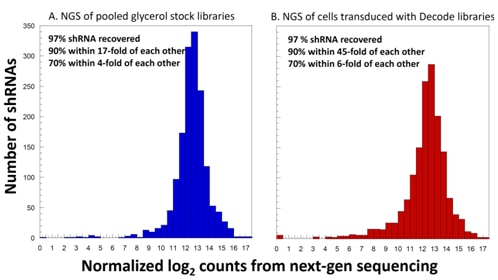
Plasmid DNA was isolated from the Decode Phosphatase glycerol stock pool containing 1561 shRNAs targeting 254 genes (A). Genomic DNA was isolated from HEK293T cells that were transduced with the Decode Phosphatase library at a 1000-fold shRNA representation (B). Both DNA samples were sequenced on an Illumina Hi-Seq to determine the shRNA represented in the samples. Histograms of the normalized log2 counts show that shRNAs recovered after the pooling process (glycerol stock) and after transduction with lentiviral particles are represented with tight distributions. This ensures there is ample representation of each shRNA in the screening experiment.
Successful pooled screening requires a high construct fold representation
Critical to the success of your screen and identification of quality hits is performing the screen at a high fold representation (the extent to which any given construct (e.g., shRNA) in a pooled library will be represented in the screen). High construct representation results in a greater degree of reproducibility between biological replicates and ensures that there is a sufficient experimental window for detection of changes in representation after phenotypic selection.
Horizon provides the tools necessary to reproducibly identify hits with confidence
- All constitutive promoter lentiviral screening libraries are provided as concentrated (≥ 108TU/mL) lentiviral particles in sufficient quantity to transduce multiple biological replicates. Libraries with an inducible reporter are provided at ≥ 107TU/mL.
- Optimized and experimentally validated product-specific PCR primers are designed to efficiently amplify genomic DNA with minimal bias and allow downstream high-throughput sequencing analysis of construct abundance
- Sufficient quantity of lentiviral particles, PCR and sequencing primers allow the maintenance of high fold representation throughout the entire screening process
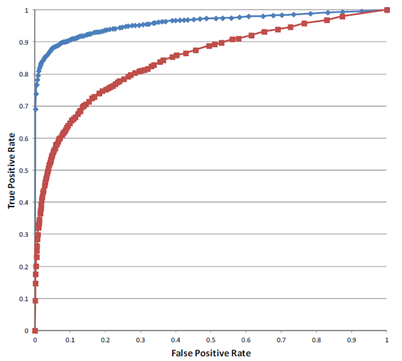
The Receiver Operating Characteristic (ROC) curves for a screen of 10,000 shRNAs at 100- (red) and 500-fold (blue) shRNA representation for detecting two-fold enrichment and depletion. The 500-fold screen has a larger area under the ROC curve and a higher true positive rate than the 100-fold screen, demonstrating the superior ability of the 500-fold screen to detect enriched and depleted shRNAs.
Reproducibility between replicates is maintained through PCR steps by following experimental protocols
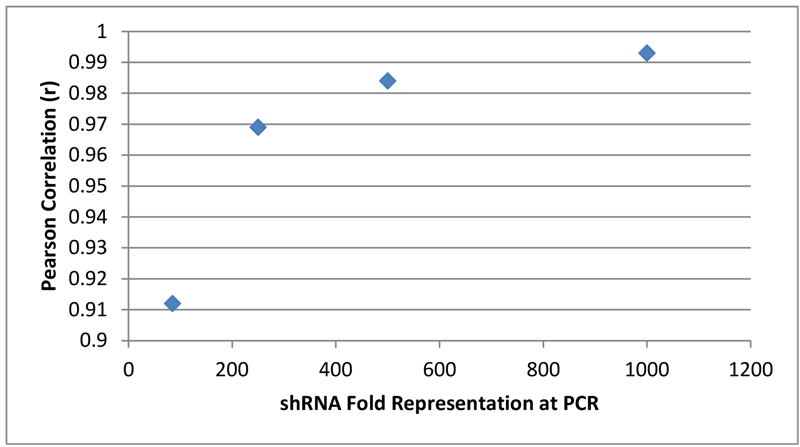
The Decode phosphatase library was transduced into HEK293T cells at 1,000-fold representation. Cells were selected with puromycin for 72 hours and genomic (gDNA) was isolated. Decode PCR primers were used to amplify shRNA sequences at indicated fold representations. Technical replicates of each PCR were compared to determine reproducibility (Pearson Correlation), where 1.0 indicates that the samples are 100% identical.
Successful pooled screening requires a high fold representation of each construct
Each step of the pooled screening workflow, from transduction to hit identification, has been empirically tested. Amplification conditions were identified to ensure uniform amplification and high reproducibility (Strezoska et al. 2012). Dharmacon pooled screening systems includes Illumina-adapted PCR primers for identification of hairpin sequences from gDNA by high-throughput sequencing on Illumina instrumentation. Decode and SMARTvector primer pairs are optimized for efficient amplification of the construct while minimizing thermodynamic bias and variation in representation. In addition, PCR primers have built-in adaptor and index sequences that allow the researcher to easily move from PCR amplification to Illumina high-throughput sequencing. Direct identification of hairpin insert facilitates data analysis and ensures accurate target gene identification.
PCR amplification and Illumina high-throughput sequencing workflow

Illumina-adapted primers and Phusion Hot Start II High-Fidelity DNA Polymerase are used to PCR amplify integrated shRNA sequences and add Illumina flow-cell binding sequences. The resulting amplicons are run on Illumina platform sequencers, using the sequencing primers provided. shRNAs that are enriched or depleted during the screen are identified as hits, and the genes that they target are identified. Hits can be confirmed and studied further using individual GIPZ lentiviral shRNAs.
Next-generation sequencing protocol is reproducible so that experimental noise is reduced and hits are more easily identified
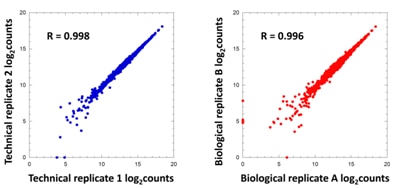
The Decode Phosphatase pooled screening library was transduced into HEK293T cells at 1000-fold shRNA representation. Cells were selected with puromycin for 72 hours and genomic DNA (gDNA) was isolated. Decode PCR and Sequencing primers were used to amplify and sequence gDNA samples as two technical duplicates (blue) and two different transductions (red) and counts analyzed by Illumina high-throughput sequencing. The log2 counts of shRNAs for each of the replicates are plotted against each other.
Select any SMARTvector lentiviral shRNA, SMARTvector Inducible Lentiviral shRNA, shMIMIC Lentiviral microRNA, shMIMIC Inducible Lentiviral microRNA, or GIPZ construct for human, mouse, or rat (where available).
- Available pool sizes are between 50 to 10,000 constructs
- Pools are provided as purified, concentrated lentiviral particles (≥ 5 x 108TU/mL for constitutive vectors and ≥ 1 x 107TU/mL for inducible vectors)
- Choose lentiviral particle quantity (minimum volume 100 µL)
- Prior to viral production, pools are analyzed for recovery and uniformity of constructs by NGS analysis
- A data file which includes construct sequences, RefSeq gene accessions, Entrez gene IDs or miRBase gene IDs, and counts per millions of mapped reads is provided
Horizon products recommended in our validated Pooled Lentiviral Screening protocol:
- Non-targeting control lentivirus for transduction optimization
- Vector-specific Indexing PCR and Sequencing Primer Kits which includes optimized and experimentally validated primers for:
- Efficient PCR amplification of genomic DNA with minimal bias and
- High-throughput multiplexed sequencing for hit identification
- Experimentally tested protocols and planning tools for successful pooled lentiviral screens
Before requesting a quote, download these invaluable tools to carefully plan your pooled lentiviral screen and calculate the amounts of components required:
- Pooled Lentiviral Screening Libraries Technical Manual
- Laboratory Protocols and Calculation Tracking Worksheet
- Bioinformatics documentation
Important Notice
The pooled lentiviral screening libraries and reagents are solely for internal research use (as set forth in the Product Terms and Conditions) in laboratories where the containment measures stated below and in applicable laws and regulations are met. Products may not be used for diagnostic, therapeutic or other commercial purposes and may not to be administered to humans for any purpose or to animals for therapeutic purposes. All pooled lentiviral screening libraries provided as lentiviral particles are replication-incompetent, self-inactivating (SIN) and non-pathogenic (do not cause infectious human disease).
Any investigator who purchases lentiviral particle products is responsible for consulting with their institution's health and biosafety personnel for specific guidelines on the handling of lentiviral vector particles. Furthermore, each investigator is fully responsible for obtaining the required permissions for research using and the acceptance of replication-incompetent SIN lentiviral vectors and replication-defective lentiviral particles into their local jurisdiction and institution.
